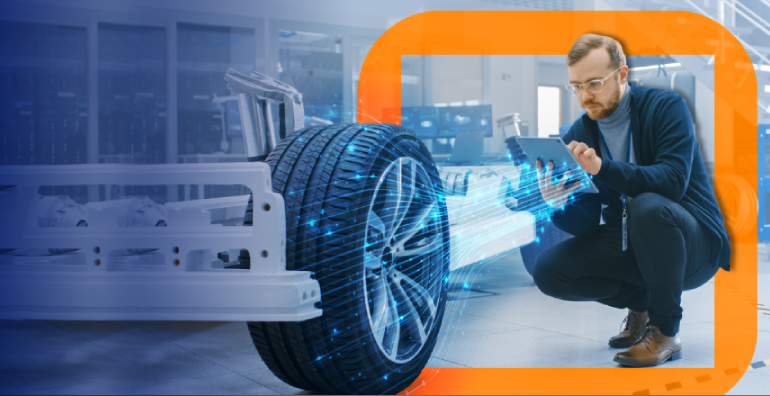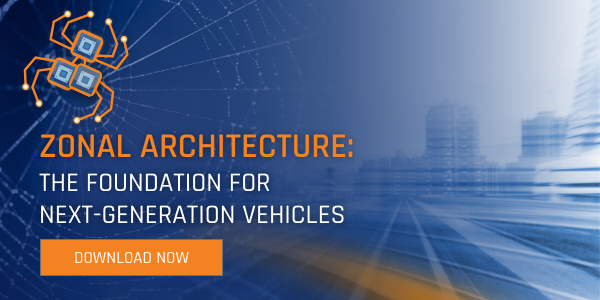Why Modularity is a Gamechanger for the Software-Defined Vehicle
June 26, 2023
The automotive industry is moving from the traditional car model to the software-defined vehicle (SDV), which will be designed, made, sold, and serviced very differently from current industry norms. Instead of the hundred of ECUs built into cars today, in the future multiple functions and communication interfaces will consolidated using Automotive Zonal Architecture and other next-gen E/E Architectures that provide enhanced driving experiences utilizing fewer ECUs and a much smaller cable harness.
This shift is driven by consumer demand for vehicles to provide similar customization and upgradability functionality as they find on their PCs and smartphones. But with a time to market measured in months and years, the automotive industry is far from this reality.
Zonal Architecture incorporates hardware and software modularity, paving the way for easy installation of plug & play ECUs that can be switched out based on manufacturer updates or customer demands. This modularity significantly shortens update cycles to weeks and removes the need for extensive re-testing of the entire system for each change in any of the vehicle’s components or software.
This shift brings significant benefits to automakers - particularly regarding supply chain optimization and time to market for new features or updates.
Benefit #1: Reduced Time to Market
Based on the current vehicle architecture, it can take months for a new feature to be added. This is because each vehicle is made up of multiple ECUs from dozens of suppliers, with each supplier using their own software stack. Any required maintenance or update involves changing the entire system - a logistical and managerial nightmare.
Here’s where modularity is a game-changer. With streamlined development, the code inside the vehicle will no longer be monolithic and will allow different model configurations during or after the production cycle that can be tested independently. This flexibility shortens the time to market for adding vehicle features down to a matter of weeks. Engineers can design functionality in a simple way while resting easy that their business logic or code will not be obsolete by implementation time.
The faster new features can be brought to market, the more drivers benefit from unique customizations as well as over-the-air updates that will no longer be measured in quarters or years of waiting and require a trip to the garage. Automakers will be able to stay ahead of the competition with fast updates and keep their customers happy.
Benefit #2: Increased Vehicle Potential
Modularization allows OEMs to offer simple base models with a variety of exciting personalized add-ons for customers to design their dream vehicle. Instead of producing a number of different models, each with its own set of features, customers can choose what to add on after purchase (much like buying apps on a smartphone) as new features are launched or their needs change.
The vehicles can even “learn” from drivers’ behavior over time and offer suggestions of software services or features tailored to their needs. It will be more cost-effective for consumers to purchase new features for their existing car than to purchase a new car for new features unavailable today during post-production. This could even lead to the residual value of the car increasing over its lifetime as additional features are added OTA.
Benefit #3: The Value of Data
Ongoing customer engagement is the key to repeat sales in most industries, especially in automotive. In fact, fostering the customer-brand relationship can result in a closing rate of 75% on future sales. SDVs will increase customer engagement as frequent software updates will be an integral part of the ongoing relationship between OEMs and drivers.
Businesses value quality over quantity. The quality of customer-brand engagement and the driver-behavior and preferences data collected by the SDV will provide OEMs with valuable information that will help ensure that future apps and new developments fit the needs and behaviors of drivers. This data collected by the car is automatically stored in large data lakes that are accessible (with certain privacy restrictions in place) to manufacturers, engineers, and others to use specifically for improving the design of their products.
In addition to the more general data that can be used to inform the development of future features and products, specific driver data can also be used to enhance that particular driver’s experience. Drivers can be given personalized recommendations that match their needs to maximize their driving experience and vehicle ownership.

Benefit #4: New Revenue Streams
Hardware and software modularity provides automakers with a new level of flexibility and scalability, opening up ample opportunities for new revenue streams to turn drivers into subscribers to paid services.
Today, a customer makes a one-time vehicle purchase from an auto manufacturer, and that manufacturer has little to no additional revenue from the driver once they leave the lot. In the future, modularity in the software-defined vehicle will allow for the development and deployment of new features and applications that are constantly updatable via the cloud, prolonging the relationship and increasing the OEM’s profits, when drivers feel that the subscription offers sufficient value.
For example, Porsche already offers owners to sign up for Porsche Connect and choose relevant subscription services while BMW’s controversial decision to offer seat warming in some markets as a subscription service became big headlines when it was announced.. Drivers are primarily happy to pay for services they feel offer an upgrade or a better experience as they can choose which features they want and which they want to skip. The savvy OEMs that capitalize effectively on this opportunity will differentiate their brand by offering a personalized device that perfectly suits each customer's unique needs.
Naturally, it will take some trial and error for automakers to learn which services will generate the most demand (and the most revenue). By building hardware with future upgrades in mind, adding those changes later will be easier for the developers and more cost-effective for OEMs.
The New Relationship Between Drivers and OEMs
The modular nature of software-defined vehicles will make it easier and more cost-effective for OEMs to upgrade existing functionalities and add new features as demanded by customers. This will lead to a closer and longer-term relationship between OEMs and drivers, different from any that has existed before. OEMs will better understand drivers on an individual basis and will be able to respond quickly and efficiently to driver needs and desires. The modular SDV will benefit everyone throughout the automotive value chain and change the way drivers and owners relate to, and use vehicles.






